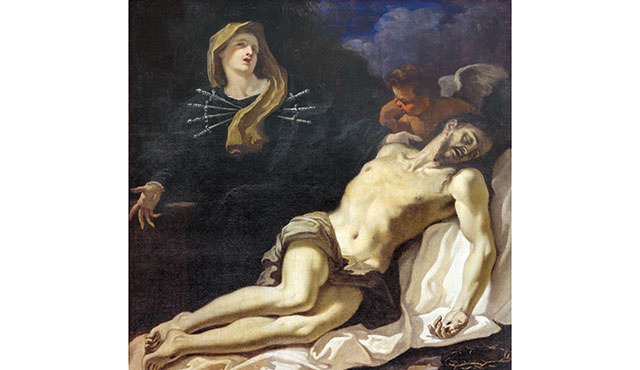Holy Mary lived a life of great joy as Mother of God, but with it came sacrifice and sorrow. The Seven Sorrows of Mary define her life and story, spanning the years of Jesus’ life and death. We revere her sacrifice and pray her rosary to remember the events she endured.
One of the first painful events in Mary’s life as a new mother is also one of the meditations of the joyful mysteries of the rosary, “The Presentation of the Child Jesus in the Temple.” While we rejoice in the significance of this occasion, we also remember that Mary fully lived through this event as a mother who was filled with joy in bringing her only son to the temple to complete the redemption ritual of the firstborn, but also deep sorrow as Simeon prophesied to her of what was to come for her son and her: “…And a sword will pierce your own soul, too…” (Luke 2:34-35). This occasion and six other events in the life of the Blessed Mother invite us to participate in devotions dedicated to the Seven Sorrows of Mary:
- The Prophecy of Simeon (Luke 2:25-35)
- The flight into Egypt (Matthew 2:13-14)
- The loss of the Child Jesus in the temple for three days (Luke 2:43-45)
- The carrying of the cross (John 19:17)
- The crucifixion of Jesus (John 19:18, 25-27)
- The taking down of Jesus’ body from the Cross (Mark 15:43)
- The burial of Jesus (John 19: 39-42)
Various devotions to Mary were abundant in earlier centuries so the exact origin of the seven sorrows devotion is unclear. However, it is known that in the 4th century Blessed Henry Susso is credited for meditations he called the Five Joys of Mary and the Five Sorrows of Mary. In another source, St. Alphonsus Ligouri wrote in his book, “The Glories of Mary,” that the Blessed Mother appeared to seven of her servants and asked them to meditate upon her dolors, or sorrows. These seven founded the order of the Servants of Mary, or Servites, in 1239. In 1482 the five sorrows developed into seven as Father John de Coudenberghe began preaching the Seven Sorrows of Mary. In 1814, the feast of Our Lady of Sorrows was officially added to the Roman calendar on September 15, the day after the feast of the Holy Cross.
In the 14th century, the Blessed Mother revealed to St. Bridget of Sweden seven promises and graces to those who prayed seven Hail Marys while meditating on the seven sorrowful events of her life:
- “I will grant peace to their families.”
- They will be enlightened about the divine Mysteries.”
- “I will console them in their pains and will accompany them in their work.”
- “I will give them as much as they ask for as long as it does not oppose the adorable will of my divine Son or the sanctification of their souls.”
- “I will defend them in their spiritual battles with the infernal enemy and I will protect them at every instant of their lives.”
- “I will visibly help them at the moment of their death– they will see the face of their mother.”
- “I have obtained this grace from my divine Son, that those who propagate this devotion to my tears and dolors will be taken directly from this earthly life to eternal happiness, since all their sins will be forgiven and my Son will be their eternal consolation and joy.”
Fr. Quan Tran, parochial vicar of St. Bonaventure parish in Huntington Beach, wrote extensively on the Blessed Virgin Mary, the meaning of grace and the effects of grace in his book, “The Imitation of Mary: How to Grow in Virtue and Merit God’s Grace.”
“Supernatural grace is a gift from God that allows us to participate in His supernatural life. It really conforms us to God and makes us holy. It prepares us for heaven. So, part of the definition of grace is that it requires a response on our part,” explains Fr. Tran. “It’s a gift from God but it’s more of an invitation to respond to His call, to His life and His nature. And when we respond, we grow in grace. We become more holy and we start to do his Will. We allow Him to work in us and through us to be His instrument in the world just like Mary.”
He further explains that in Mary’s suffering, she gained many graces for us as well.
“In the seven sorrows of Mary, we see her participating in God’s plan of salvation. God has chosen her to play a huge part in His plan and to be the mother of Jesus. To be a model for us in terms of discipleship in leading us to God. She is the most perfect of all His disciples. She is God’s masterpiece. Mary has complete free will and she chooses to use that free will perfectly. She is known to be full of grace because she cooperates with God’s will. She conforms herself to God’s will.”
Fr. Tran also explains that one of the effects of grace is that it heals us because of our fallen human nature.
“We tend to sin, rebel against God, go after things that are superficial and harmful to others and offensive to God. Because of that wound, grace heals us. We do need that spiritual healing in order to become that person that God made us to be,” he said. “Grace is medicinal, it heals our soul. It makes us whole again in every way.”

